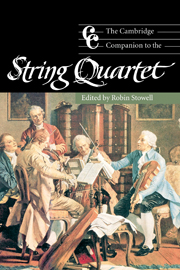Book contents
- Frontmatter
- Part I Social changes and organological developments
- Part II Celebrated ensembles
- Part III Playing string quartets
- Part IV The string quartet repertory
- 8 The origins of the quartet
- 9 Haydn, Mozart and their contemporaries
- 10 Beethoven and the Viennese legacy
- 11 The Austro-Germanic quartet tradition in the nineteenth century
- 12 Traditional and progressive nineteenth-century trends: France, Italy, Great Britain and America
- 13 Nineteenth-century national traditions and the string quartet
- 14 The string quartet in the twentieth century
- 15 The string quartet as a foundation for larger ensembles
- Notes
- Select bibliography
- Index
8 - The origins of the quartet
from Part IV - The string quartet repertory
Published online by Cambridge University Press: 28 September 2011
- Frontmatter
- Part I Social changes and organological developments
- Part II Celebrated ensembles
- Part III Playing string quartets
- Part IV The string quartet repertory
- 8 The origins of the quartet
- 9 Haydn, Mozart and their contemporaries
- 10 Beethoven and the Viennese legacy
- 11 The Austro-Germanic quartet tradition in the nineteenth century
- 12 Traditional and progressive nineteenth-century trends: France, Italy, Great Britain and America
- 13 Nineteenth-century national traditions and the string quartet
- 14 The string quartet in the twentieth century
- 15 The string quartet as a foundation for larger ensembles
- Notes
- Select bibliography
- Index
Summary
In the months that followed the death of Joseph Haydn in May 1809 the Leipzig journal Allgemeine musikalische Zeitung published a biography of the composer in eight instalments. Written by Georg August Griesinger and subsequently published as a single volume, it had been prepared in Vienna over a period of some ten years during which Griesinger had won the confidence of the composer. Its factual content and its tonewere to play a significant part indetermining the posthumous image of the composer. Both Griesinger and Haydn were conscious of the international esteem in which the composer was held and the biography sought to explore, through an attractive mixture of direct quotation, anecdote and reverential comment, how he had achieved this pre-eminence. Since the genre of the quartet was central to this fame Griesinger attempted to shed light on how Haydn had first come to compose such works:
the following purely chance circumstance had led him to try his luck at the composition of quartets. A Baron Fürnbeg had a place in Weinzierl, several stages from Vienna [about fifty miles], and he invited from time to time his pastor, his manager, Haydn, and Albrechtsberger (a brother of the celebrated contrapuntist, who played the violoncello) in order to have a little music. Fürnberg requested Haydn to compose something that could be performed by these four amateurs. Haydn, then eighteen years old, took up this proposal, and so originated his first quartet [quotation of opening of Op. 1 no. 1], which, immediately it appeared, received such general approval that Haydn took courage to work further in this form.
- Type
- Chapter
- Information
- The Cambridge Companion to the String Quartet , pp. 175 - 184Publisher: Cambridge University PressPrint publication year: 2003

